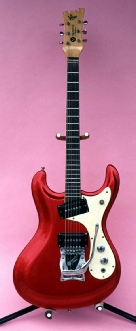


Mosrite Guitar History
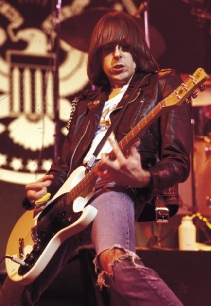
Mosrite Guitar is the top wish of every serious guitar collector’s Christmas wish list. Known for their narrow small profile low fretted necks, high powered pick ups and innovative designs, Mosrite Guitars have been played by leading musicians in virtually every music venue. From Buck Owens to Johnny Ramone to Kurt Cobain, they’ve all owned and played a Mosrite. Jimi Hendrix owned two of them, one of which is on display in The Rock and Roll Hall of Fame. Just who was the man that designed and produced the Mosrite line of instruments and how was Mosrite of California created?
Semie Moseley
Semie Moseley, born in 1935 in Durant, Oklahoma, migrated west with his family,
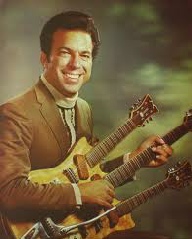
modern solid body guitars for Merle Travis in 1948.
Semie Moseley started designing and building guitars in his garage. He designed and built a triple necked guitar in 1954. The lowest (longest) neck was a standard six string guitar, the middle neck was a six string that was tuned an octive higher. The top neck, the shortest, was an eight string mandolin. He also designed a double neck guitar that he gave to popular country guitarist Joe Maphis.
The Birth Of The Mosrite Guitar
Semie Moseley’s friend Ray Boatright, known as
The Singing Preacher, was a minister in Watts, California. Extremely impressed with Semie's guitar designs, Boatright provided financial backing and in 1956 Semie and Andy created Mosrite of California. Semie, who was still employed by Rickenbacker at the time, was fired when management learned that he was producing his own instruments. At that point, Semie and Andy became solely self employed and Mosrite Of California was now in a sink or swim situation. The company stayed afloat by selling special order hand made custom guitars to musicians in Los Angeles and Nashville. In 1959, the company was moved to Bakersfield, where Standell, Grugget and Hallmark guitar companies
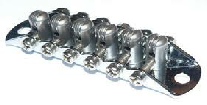
were also located.
Unlike his competitors, Semie Moseley continually improved his guitars. He designed and built the Vibramute Vibrato unit (which was redesigned and renamed in 1965) and the Rollermatic Bridge. The Rollermatic Bridge was a very advanced superior design. Each string had
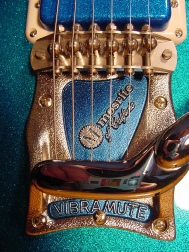
a separate adjustable tower which contained a string roller at the top.The guitar string was supported by the roller, which greatly reduced string friction
settling in Bakersfield, California around 1940. During his early teenage years, Semie picked up the guitar, honing his skills playing with local gospel groups. Raised in a Pentacostal family, Semie had staunch religious convictions and loved Gospel Music. He would later build what he named Gospel Guitars and tour the United States playing in churches of all denominations. Semie passionately felt that gospel musicians were doing important work for the Lord, so they should have the finest instruments available, even if they couldn’t afford them. Consequently, Semie gave away dozens of Gospel Guitars on his tours. Not only was Semie a naturally talented guitarist, he was also a very good singer. But Semie's true passion was not performing. He was intrigued by the guitar itself and he was destined to become a legendary, innovative leader in guitar design and production.
During their teenage years, Semie Moseley and his older brother Andy repaired and refinished guitars in their small work shop at home. In 1952, Semie moved to Los Angeles to work at The Rickenbacker Guitar Factory. There he was under the tutelage of renowned German luthier Roger Rossmeisi, who was known for the German Carve and developed the neck through body design for Rickenbacker. During this time period, Semie also worked with Paul Bigsby, who designed the Bigsby Vibrato and had built
and allowed the tension between the nut and the bridge to constantly remain equal to the tension from the bridge to the string stop. This not only assisted in tuning but also reduced string wear.
The 1960’s models had high output pick ups and narrow small profile necks with thin low rounded frets. This neck design took less effort to
play and allowed the player to slide up and down the neck faster. The Mosrite solid bodies had the distinctive German Carve and were beautifully finished. Semie Moseley also produced a line of high quality acoustic guitars, the Celebrity and Serenade Series, which were also quite successful.
The Ventures
Mosrite Guitar sales received a gigantic boost in 1963 when Nokie Edwards, lead guitarist
for the Seattle based surf-
The Ventures’ huge success in Japan benefitted Mosrite immensely. Mosrite Guitars, exclusively featured on all The Ventures album covers, became very popular in the Far East and thousands were sold. The suggested retail price for a Ventures Model was $462.00, which was twice the price of a Fender Stratocaster. Mosrite of California grew to a staff level of over 100 employees and produced everything in house except the tuning keys. At this point, they were producing approximately one thousand instruments a month. They built doubleneck and triple neck guitars, standard hollow body and solid body electric guitars, acoustic guitars, dobros and mandolins. It is estimated that Mosrite of California produced and sold over 50,000 instruments from 1956 to 1969.
The Demise Of Mosrite
In 1968 the marketing agreement with The Ventures
In 1970, Semie Moseley was able buy back the rights to the Mosrite name and started building guitars. He produced innovative, high quality beautifully finshed guitars until his death from bone cancer in August of 1992. Mosrite resurfaced in 2008 when Semie’s daughter, Dana Moseley, began selling the Mosrite Guitar on line through her website. They are now producing The Semie Moseley Series, models ’63 and ’65. Both models are built to the exact specifications of the original production models and are 100% hand made.
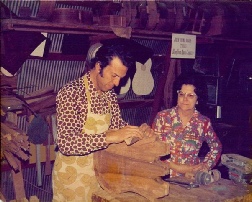
Semie Moseley was a man among men. He was an accomplished guitarist, an artist, a genius in guitar design and an extraordinary man of high character. He created a line of instruments in the 1960’s that were superior to what was on the market and are still sought after today. All of his guitars are a testament to his innovative designs and guitar building skills. It is true, that no guitar collection is complete without a Mosrite Guitar.
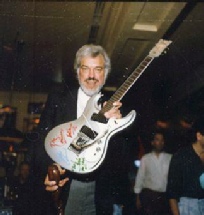
expired and Semie Moseley entered into an exclusive distribution contract with The Thomas Organ Company of California. Unfortunately, this agreement was the demise of Mosrite of California. The Thomas Organ Company was the North American manufacturer and distributor of Vox amplifiers, organs, guitars and guitar effects pedals. All was not well with Vox amplifiers and organs at that time. In 1964, Vox was sold to the Royston Group, an over extended English investment firm and had splintered into two factions. There was no longer a central manufacturing facility. The British and The North American Distributors were also the manufacturers, which meant that Thomas Organ Company was the North American manufacturer. As a result, the quality of construction, sound and reliability dropped significantly compared to their high point in 1966. Sales were drastically down. Popular rock groups, such as The Doors, switched from the Vox Continental Organ to the Gibson Kalamazoo because of reliability issues. Many bands used Vox Amplifiers as stage props, using the classical cosmetic styling to hide the Fender or Marshall Amplifiers that were really being played. Vox also marketed a line of six and twelve string guitars, which also weren’t selling well.
Thomas Organ not only failed to successfully market Vox products, they didn’t sell
any Mosrites either. We will never know if the distribution deal was a conspiracy
by Thomas Organ to kill off a competitor, but that was the ultimate result. Semie
Moseley filed for bankruptcy on Valentines Day in 1969. Semie and Andy tried to reorganize
and save the company, by-
The Resurrection Of Mosrite
